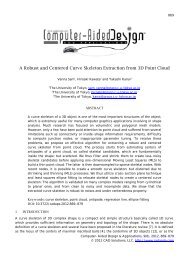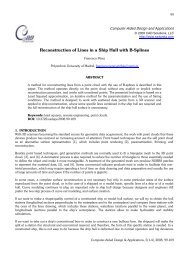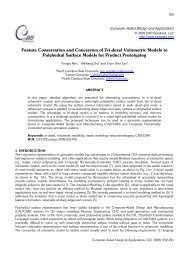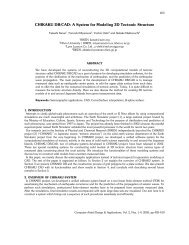A Virtual Sculpting System Based on Triple Dexel Models with Haptics
A Virtual Sculpting System Based on Triple Dexel Models with Haptics
A Virtual Sculpting System Based on Triple Dexel Models with Haptics
You also want an ePaper? Increase the reach of your titles
YUMPU automatically turns print PDFs into web optimized ePapers that Google loves.
654<br />
the index of the dexel data which can reflect the x and y values of the dexel. Then, a 2D bounding box<br />
in XY plane is calculated which encloses the virtual tool as shown in Fig. 10(a). Suppose the bounding<br />
box is represented by four corner vertices <strong>with</strong> the indices of (i, j), (i+m-1, j), (i, j+n-1) and (i+m-1, i+n-<br />
1). It is straightforward to locate the dexel data of the workpiece <strong>with</strong>in the bounding box. Here the<br />
workpiece dexel data is indicated as <strong>Dexel</strong>W(I, J). The z values of <strong>Dexel</strong>T(I, J) and <strong>Dexel</strong>W(I, J) are<br />
compared as shown in Fig. 10(b). The six relati<strong>on</strong>ships described in the Boolean Difference algorithm as<br />
shown in Fig. 4 are used to identify the collisi<strong>on</strong>. If any case of “CutIn”, “CutOut”, “CutAll” or “Merge”<br />
happens, there is a collisi<strong>on</strong>. Otherwise there is no collisi<strong>on</strong>.<br />
Fig. 10: Collisi<strong>on</strong> detecti<strong>on</strong> based <strong>on</strong> dexel data.<br />
Compared to the workpiece, the virtual tool is relative small. By using the bounding box, <strong>on</strong>ly small<br />
amount of dexel data is searched for the collisi<strong>on</strong> detecti<strong>on</strong> purpose. The detecti<strong>on</strong> is accomplished by<br />
simply comparing a single depth value. Same process is executed using the dexel data in y and z<br />
directi<strong>on</strong>s. A fast and accurate collisi<strong>on</strong> detecti<strong>on</strong> to sustain the requirements discussed earlier in this<br />
secti<strong>on</strong> can be achieved.<br />
5.2 Force Generati<strong>on</strong><br />
The god-object c<strong>on</strong>cept suggested by Zilles and Salisbury [33] is adopted to haptically render the dexel<br />
model in the virtual sculpting system. Simply the virtual tool tracked by haptic device is simulated as a<br />
single point called the Haptic Interface Point (HIP). The ideal haptic interface point (IHIP) is c<strong>on</strong>sidered<br />
to follow the trace of the HIP. The HIP can penetrate the object and the IHIP is c<strong>on</strong>strained <strong>on</strong> the<br />
surface such that it doesn’t penetrate any object.<br />
When a collisi<strong>on</strong> is detected, the first step of the force generati<strong>on</strong> algorithm is to extract a virtual<br />
boundary surface which will be utilized to interact <strong>with</strong> the virtual tool. Due to the stringent<br />
requirement of 1K Hz update rate, it is impossible to c<strong>on</strong>struct the surface for the whole design model.<br />
The x and y positi<strong>on</strong> of the HIP can be tracked from the haptic device. As illustrated in Fig. 11(a)., the<br />
dexel points P1, P2 and P3 which c<strong>on</strong>tain the HIP can be located so that they form a triangle. The HIP is<br />
enclosed in this triangle called “active triangle”. As illustrated in Fig. 11(b)., a virtual surface can be<br />
modeled as an elastic element. Then the reacti<strong>on</strong> force acting <strong>on</strong> the tool during the interacti<strong>on</strong> will be:<br />
(5.1)<br />
where is the stiffness coefficient, is the damping coefficient, is displacement and is<br />
velocity. For fricti<strong>on</strong>less interacti<strong>on</strong>s, the reacti<strong>on</strong> force F is normal to surface of the object that the<br />
sculpting tool collides <strong>with</strong>. Keeping the stiffness coefficient low would make the surface perceived<br />
soft. If the virtual tool penetrates the object, the active triangle is c<strong>on</strong>structed as shown in Fig. 11(a).<br />
The Ideal Haptic Interface Point (IHIP) stays <strong>on</strong> this surface. Then the nearest distance from the current<br />
HIP to the active triangle is calculated. As l<strong>on</strong>g as the tool moves out the covering range of the active<br />
triangle, a new triangle is formed as the new active triangle.<br />
Computer-Aided Design & Applicati<strong>on</strong>s, 6(5), 2009, 645-659








